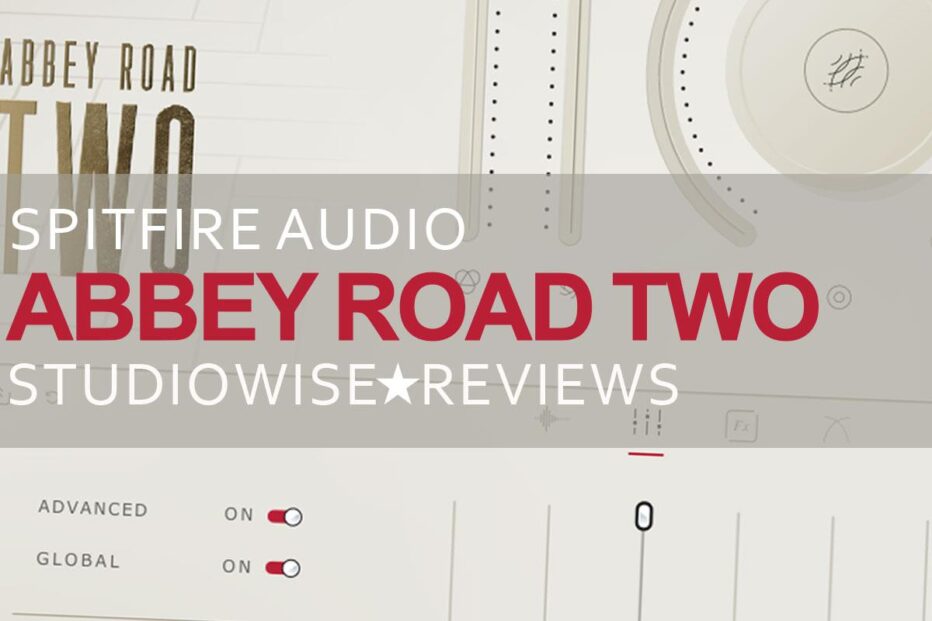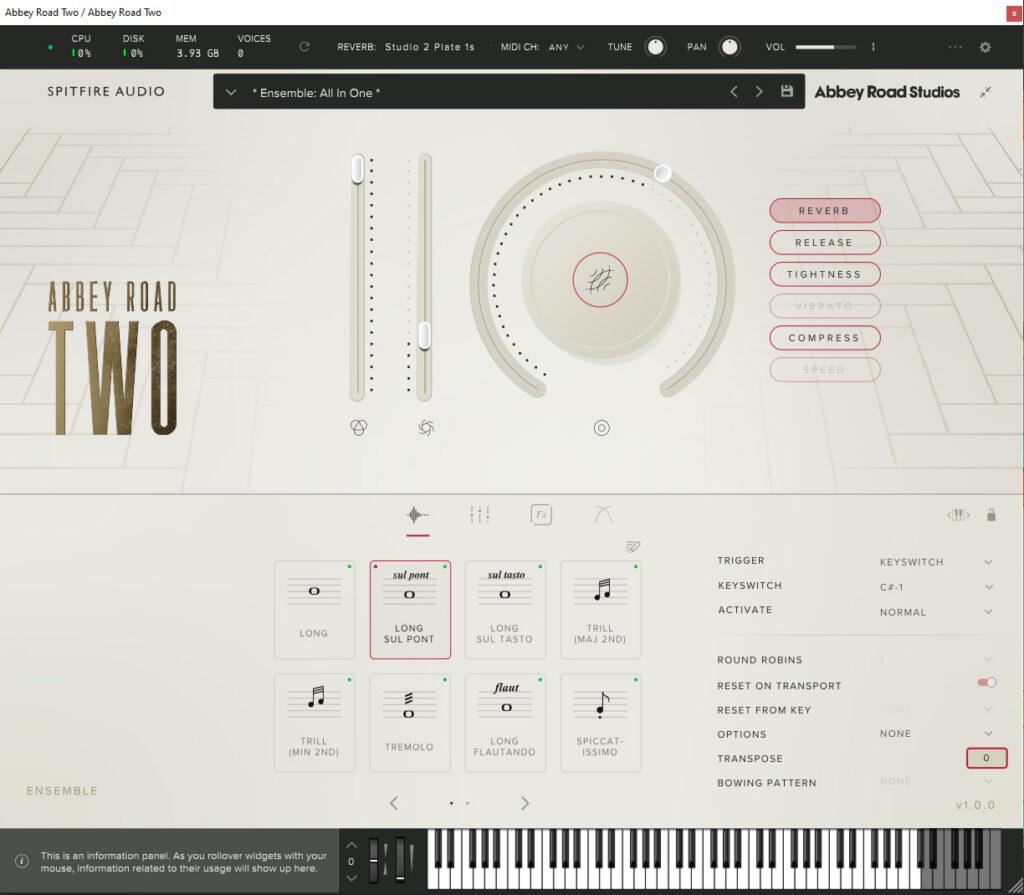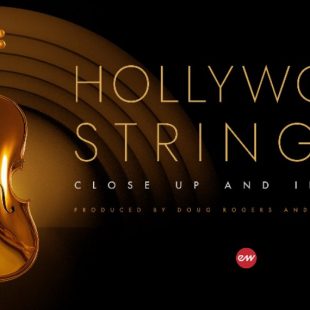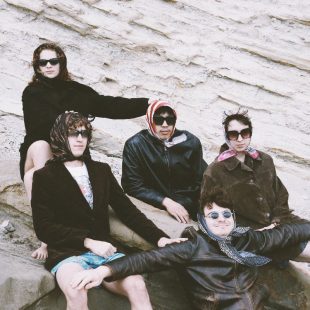Spitfire Audio Abbey Road Two, Iconic Strings
Hello and welcome back to Music Nation StudioWise and our first hands-on review for 2023. Looking forward to another great year of pro audio titles.
Spitfire Audio are well established now as one of the premier developers for contemporary sample libraries, filling nearly every gap in the market with a multitude of offerings. As an English company it’s only natural they focus on local iconic locations such as the famous Abbey Road Studios, committing a substantial amount of time and human resources to producing very detailed products around the historic venue.
With the reckoning that both all things ‘Beatles’ must be derived from a higher level of genius, and an overload of old vintage equipment must also equal higher quality, Abbey Road Two ticks both buzz headings. Marketed as somewhat of an expansion to the previous 2019 Abbey Road One core orchestra library, this features the same GUI and basic microphone options though the band was recorded in the smaller and more intimate studio two as the namesake indicates.
Out of the Box
While I hate to begin on a negative note, I must express my disapproval of Spitfire Audio’s proprietary GUI. Though stylistically attractive, I find it overly ostentatious and clunky, and it lacks a basic function to purge samples, making libraries less efficient in larger templates compared to their Kontakt counterparts. While I understand the importance of cost considerations in today’s business landscape, I do wish they would either provide a Kontakt alternative or just implement sample purging.
Spitfire’s style over functionality GUI uses over half the available real estate for a single large knob, then awkwardly hides away most of the important articulations and microphone controls.
Confusingly, all of the ‘big knob’ functions are again replicated in the FX window. Why this is needed is beyond me.
Articulations are set by default to key switching with no way to globally convert to MIDI channel select, which is where most composers would want to be. You’ll need to one-by-one go through each articulation to convert it to a MIDI trigger and assign a MIDI channel. Very painful.
There is no arguing Abbey Road Two looks great, with its scalable subtle white-on-tan styling and cinematic style fonts. The instrument defaults to the Spiccato patch when loaded, clearly, they are keen to highlight the library’s Eleanore Rigby party trick as quickly as possible.
In Use
My initial impressions of Abbey Road Two were quite jarring. Having tuned my ears to the large ensemble sound of the BBC Symphony Orchestra, which has become my go-to library, I expected Abbey Road Two to be somewhat similar. However, I wasn’t quite prepared for the raw and gritty sound it presented. The recordings are incredibly detailed, capturing the delicate nuances of the bows and slight phase shifts as the players move while performing. It’s even possible to hear the players’ breathing if you turn up the volume high enough.
The high violins and viola are very naked. By this I mean the low instruments draw a certain amount of reverberation from the room due to the amount of sound pressure they are generating, they naturally sound lively.
The higher stringed notes balance on a fine line between heartbreakingly beautiful and uncomfortably shrill. The players are clearly incredibly talented as even the slightest variant in pitch would stand out horribly.
Even together there is a strong individual voice from each of the instruments you can never achieve with a larger band. It’s quite stunning to clearly hear the very defined seating arrangement, close your eyes and you’ll swear you’re sitting right in the middle of the group.
The round robins are a major highlight of the library for me, the sustains are just so convincing. The very clever looping points are all masked with timed bowing noises, harmonics and re-bow grit. Riding the dynamics fader works very well with individual instruments to further the bowing realism.
Individually each of the instruments sounds excellent. The bass and cello sound the most natural out of the box, the violins and viola needing a touch of reverb to seat them in with the band. I particularly like the viola legato, I think one of the best recordings of this articulation Spitfire Audio has done to date.
Playing through each of the included preset mic mixes reveals interesting characteristics of both the room and recording equipment. I initially liked each of the REDD Vintage mixes until I tried the Neve 88RS modern versions, particularly mix 2 which is amazing. While the slight boxiness of the vintage mixes is great if you’re going for that retro vibe, the modern mix 1 and 2 are sublime. A beautiful hi-fi sound that has great stage width and that creamy Neve compression.
Performance
This library is a real beast to work with due to its huge resource requirements. On our system, there was no chance of playing more than two or three instances at a time, and that usually entailed plenty of cracking as the CPU complained. Even writing full 5-note chords with the ensemble patch gave us crackles sometimes. You can certainly look forward to a lot of track freezing or rendering.
The included reverbs are subtle in default hall and chamber form but crank up the plate time for a wonderfully atmospheric retro vibe. I’m not a big fan of washing strings in reverb so the included effect is ample for me, but you’ll need a 3rd party plugin if you’re wanting to get more creative results. I do quite like the included compression effect, again quite subtle but very smooth and creamy with no ill effects to running it quite hot.
The most important element of an orchestral library is its playability, immersion and realism, in which all three categories of Abbey Road Two excel. Barring the odd DPS click, the sound is quite simply stunning. Not yet have I been so immersed, and so convinced I was in the same room as the players as I have with this.
Workflow
Unlike the Albion range, Abbey Road Two is not designed to play 10-finger style like a synth, but rather an individual solo instrument approach. You can certainly use the ensemble patch for nutting out ideas then split your sections out into individual tracks once you’re settled on the arrangement. I very much like this style of workflow as it feels more flexible with the individual instrument control.
Aside from the obvious track-per-instrument mixing, there is a tonality difference for the better as well. Each of the instruments really shines as single instances, not so much as soloists but rather more defined individual members of the full band. It’s much easier to hear the individual bowing and unique noises from the player, as well as much more dynamic control over velocities and vibrator than you can get from the full ensemble patches.
Having said that, this is not to say you can’t mix and match this library with other libraries like Albion One for a full sound. While all libraries have their own character and sound from the different studios they were recorded in, much of this is smudged together when played together making these tonalities not as obvious as you may think.
For instance, I mixed Abbey Road Two with the larger BBC Symphony Orchestra, and while the reverb needed a little adjustment, the end results were surprisingly coherent and balanced. The main takeaway is not to be too concerned about picking libraries from a particular series or recording location, with a little care to mixing and balancing the end results are very convincing.
Conclusion
While I have gripes about the interfaces’ needless focus on style over functionality, there is no denying Abbey Road Two Iconic Strings sounds fantastic. To be fair, once you have everything set the way you like the interface can be mostly hidden. The lack of global purge is still a major issue that needs to be addressed, but this is a library that will fit into your workflow quickly thanks to its simple articulation selection and instant playability.
The processing requirements are a major consideration, this is not the library for those with ageing machines, the payoffs are worth either the pain of constant DPS clicks and complaints or the even more financial pain of a full system upgrade required to fully let this monster loose.
I am a convert to the Abbey Road “sound”. Though the vintage tone isn’t for me, I can fully appreciate the reasonings for focusing so much on capturing it. For me, however, the modern mixes are absolutely sublime and fit so very well with all the music I write.
Spitfire Audio continue to provide absolutely stunning titles, niggles aside Abbey Road Two is one of the best for me. Though it might be brushed off as a needless DLC for the core Abbey Road Orchestra library, this very much is a library that is capable of standing on its own two feet and filling a niche.
Like the review? Shout us a cup of coffee!









